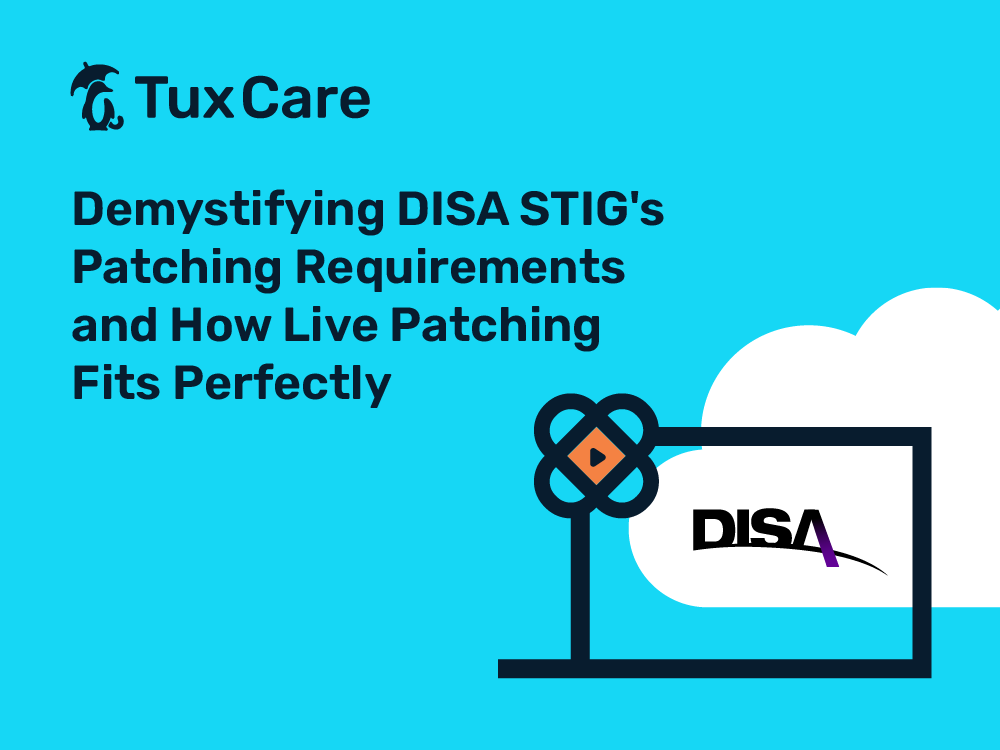Demystifying DISA STIG’s Patching Requirements and How Live Patching Fits Perfectly
The Defense Information Systems Agency (DISA) is an agency under the United States Department of Defense (DoD) responsible for planning, developing, and executing communication and information networks. One of their most notable contributions to cybersecurity is the Security Technical Implementation Guide, or DISA STIG.
For entities that are connected or planning to connect to DoD networks, understanding the intricate patching requirements set by DISA STIG is critical. The need for continuous, secure, and efficient operations has given rise to technologies such as live patching.
In this article, we’ll take a deep dive into the patching requirements of DISA STIG and explore how live patching offers an effective solution for compliance and beyond.
What Is DISA STIG?
The Security Technical Implementation Guide (STIG) is a configuration standard for DoD-accredited computer networks or systems. For any system or application that connects to DoD networks, which includes subcontractors, compliance is mandatory.
The STIG isn’t just any guide; it surpasses the common CIS benchmarks in stringency. While the latter is used globally by many organizations for security guidance, STIG is in a realm of its own. The rigorous controls stipulated in this regulation could even break general-purpose systems if not implemented with caution.
A few essential aspects about DISA STIG:
- Scope and Coverage: STIGs cover a wide range of technologies, including operating systems, applications, network devices, databases, and more. Each STIG focuses on a specific technology or software component and provides detailed guidelines for securing that component.
- Configuration Guidelines: DISA STIGs provide detailed configuration settings that need to be implemented to enhance security. These settings can cover areas such as user authentication, access controls, encryption, logging, and more.
- Vulnerability Mitigation: STIGs include recommendations for addressing known vulnerabilities and security weaknesses. This often involves applying patches, updates, or configuration changes to mitigate potential risks.
- Severity Levels: Some STIG requirements are categorized based on severity levels, such as “Critical,” “High,” “Medium,” and “Low.” This helps organizations prioritize their security efforts based on the potential impact of vulnerabilities.
- Implementation Details: Each STIG provides step-by-step implementation instructions for the security measures it outlines. These instructions help administrators and security personnel understand how to apply the recommended configurations.
- Continuous Monitoring: STIGs emphasize the importance of continuous monitoring to ensure ongoing compliance with security standards. Regular assessments and audits are recommended to identify deviations from the required configurations.
To assess and validate whether a system’s configuration meets the STIG requirements, you can use STIG SCAP profiles.
DISA STIG’s Patching Policy
Patching, in the world of cybersecurity, is the equivalent of receiving a vaccine in the human body. It’s the practice of updating software with new code to improve its functionality or fix vulnerabilities.
According to the DISA STIG framework, updates are a requisite. The frequency of these updates is determined by the site or Program Management Office (PMO). This might sound simple, but in practice, it can be a complex task. Applying patches, especially on a frequent basis, can disrupt operations and, in worst-case scenarios, even result in downtime.
Enter Live Patching
Live patching is akin to repairing a moving vehicle’s engine without needing to halt its momentum, as stopping the vehicle could cause delays or accidents. Just as fixing the engine on the go maintains the vehicle’s continuous operation, live patching allows system administrators to apply patches to a running system without rebooting. This is revolutionary, especially for critical systems where any downtime could result in financial or strategic losses.
Incorporating live patching into your compliance strategy can provide several benefits:
- Zero Patching-Related Downtime: No need to schedule a maintenance window or face potential operational disruptions.
- Enhanced Security: Instantly patch vulnerabilities without waiting for the next available reboot.
- Operational Efficiency: Save on resources, both in terms of manpower and computational power.
Embracing the Future of Patching
For businesses and systems planning to integrate with DoD networks or those already engaged, compliance is non-negotiable. As such, it’s not just about meeting these requirements but doing so in a manner that’s efficient and non-disruptive. This is where live patching shines, bridging the gap between mandatory compliance and operational excellence.
TuxCare’s KernelCare Enterprise serves as a pivotal tool in achieving compliance with these patching requirements while ensuring seamless system operations. By applying live kernel patching, KernelCare Enterprise maintains the security and stability of the Linux kernel without requiring system reboots. This unique capability enables organizations to swiftly address vulnerabilities outlined in it without disrupting critical services or undergoing downtime. KernelCare’s automated deployment of patches aligns perfectly with the regulation’’s emphasis on timely and consistent security updates. This synergy ensures that systems remain in compliance, avoiding potential security risks while maintaining continuous functionality – a crucial aspect in meeting stringent DISA STIG standards.
For more insights into leveraging advanced live-patching and ensuring compliance, check out our comprehensive guide.
While the regulation’s requirements might seem daunting, with the right strategies and tools, such as live patching, they become opportunities to bolster security, streamline operations, and achieve unparalleled reliability.



 Documentation
Documentation Login
Login




